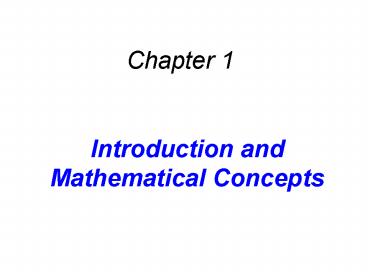Introduction and Mathematical Concepts - PowerPoint PPT Presentation
1 / 39
Title:
Introduction and Mathematical Concepts
Description:
Chapter 1 Introduction and Mathematical Concepts 1.1 The Nature of Physics 1.1 The Nature of Physics 1.2 Units 1.2 Units 1.2 Units 1.2 Units 1.2 Units 1.2 Units 1.3 ... – PowerPoint PPT presentation
Number of Views:302
Avg rating:3.0/5.0
Title: Introduction and Mathematical Concepts
1
Introduction and Mathematical Concepts
Chapter 1
2
1.1 The Nature of Physics
Physics has developed out of the efforts of men
and women to explain our physical environment.
Physics encompasses a remarkable variety of
phenomena planetary orbits radio and TV
waves magnetism lasers many more!
3
1.1 The Nature of Physics
Physics predicts how nature will behave in one
situation based on the results of experimental
data obtained in another situation.
Newtons Laws ? Rocketry Maxwells Equations
? Telecommunications
4
1.2 Units
Physics experiments involve the measurement of a
variety of quantities. These measurements should
be accurate and reproducible. The first step in
ensuring accuracy and reproducibility is defining
the units in which the measurements are made.
5
1.2 Units
SI units
meter (m) unit of length kilogram (kg) unit
of mass second (s) unit of time
6
1.2 Units
7
1.2 Units
8
1.2 Units
9
1.2 Units
The units for length, mass, and time (as well as
a few others), are regarded as base SI
units. These units are used in combination to
define additional units for other
important physical quantities such as force and
energy.
10
1.3 The Role of Units in Problem Solving
THE CONVERSION OF UNITS
1 ft 0.3048 m 1 mi 1.609 km 1 hp 746 W 1
liter 10-3 m3
11
1.3 The Role of Units in Problem Solving
Example 1 The Worlds Highest Waterfall The
highest waterfall in the world is Angel Falls in
Venezuela, with a total drop of 979.0 m. Express
this drop in feet. Since 3.281 feet 1 meter,
it follows that (3.281 feet)/(1 meter) 1
12
1.3 The Role of Units in Problem Solving
13
1.3 The Role of Units in Problem Solving
Reasoning Strategy Converting Between Units 1.
In all calculations, write down the units
explicitly. 2. Treat all units as algebraic
quantities. When identical units are divided,
they are eliminated algebraically. 3. Use the
conversion factors located on the page facing the
inside cover. Be guided by the fact that
multiplying or dividing an equation by a factor
of 1 does not alter the equation.
14
1.3 The Role of Units in Problem Solving
Example 2 Interstate Speed Limit Express the
speed limit of 65 miles/hour in terms of
meters/second. Use 5280 feet 1 mile and 3600
seconds 1 hour and 3.281 feet 1 meter.
15
1.3 The Role of Units in Problem Solving
DIMENSIONAL ANALYSIS
L length M mass T time
Is the following equation dimensionally correct?
16
1.3 The Role of Units in Problem Solving
Is the following equation dimensionally correct?
17
1.4 Trigonometry
18
1.4 Trigonometry
19
1.4 Trigonometry
20
1.4 Trigonometry
21
1.4 Trigonometry
22
1.4 Trigonometry
Pythagorean theorem
23
1.5 Scalars and Vectors
A scalar quantity is one that can be described by
a single number temperature, speed, mass A
vector quantity deals inherently with both
magnitude and direction velocity, force,
displacement
24
1.5 Scalars and Vectors
Arrows are used to represent vectors.
The direction of the arrow gives the direction
of the vector.
By convention, the length of a vector arrow is
proportional to the magnitude of the vector.
8 lb
4 lb
25
1.5 Scalars and Vectors
26
1.6 Vector Addition and Subtraction
Often it is necessary to add one vector to
another.
27
1.6 Vector Addition and Subtraction
3 m
5 m
8 m
28
1.6 Vector Addition and Subtraction
29
1.6 Vector Addition and Subtraction
2.00 m
6.00 m
30
1.6 Vector Addition and Subtraction
R
2.00 m
6.00 m
31
1.6 Vector Addition and Subtraction
6.32 m
2.00 m
6.00 m
32
1.6 Vector Addition and Subtraction
When a vector is multiplied by -1, the magnitude
of the vector remains the same, but the
direction of the vector is reversed.
33
1.6 Vector Addition and Subtraction
34
1.7 The Components of a Vector
35
1.7 The Components of a Vector
36
1.7 The Components of a Vector
It is often easier to work with the scalar
components rather than the vector components.
37
1.7 The Components of a Vector
Example A displacement vector has a magnitude of
175 m and points at an angle of 50.0 degrees
relative to the x axis. Find the x and
y components of this vector.
38
1.8 Addition of Vectors by Means of Components
39
1.8 Addition of Vectors by Means of Components































